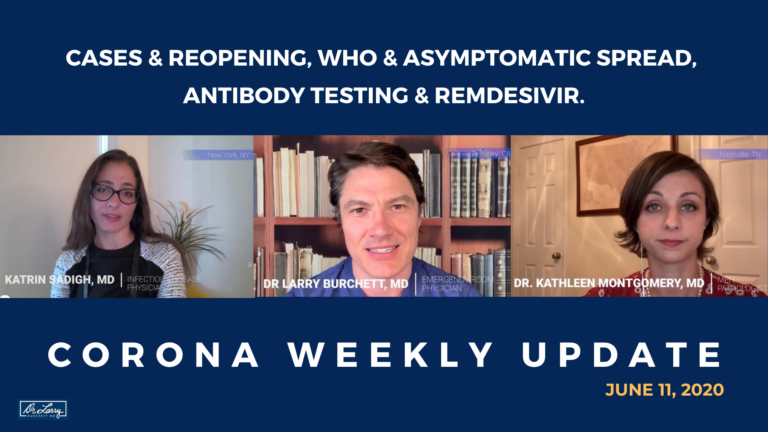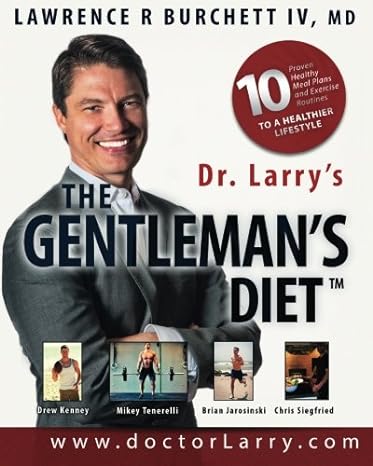Cases & Reopening, WHO & Asymptomatic Spread, Antibody Testing & Remdesivir


SUMMARY: June 11, 2020
- The WHO Misstatement On Asymptomatic Spreaders;
- Case Trends – Worldwide and Local;
- The Utility (lack there of) of Antibody Testing;
- Remdesivir, The Antiviral Treatment.
I’m Dr Larry Burchett, MD and this is your 5-minute Corona Weekly Update. This week, I’m joined by Dr Katrin Sadigh MD and Dr Kathleen Montgomery MD as we give you the evidence and facts you need to know for the week of June 11, 2020.
We start with Dr Kat Sadigh reviewing the current numbers.
CASE TRENDS – WORLDWIDE & LOCAL
KATRIN SATIGH
Globally there are just under 7.5 million total cases of COVID19 and over 417,000 deaths.
In the US, we reached over 2 million total cases of COVID19, including 150,000 new cases over the past 7 days. We had 12,000 more deaths, bringing our total estimate to over 113,000 deaths.
The number of cases in Africa alone has doubled in the last 18 days, exceeding 200,000.
The pandemic is also sweeping through Latin America and the Caribbean, leading Dr. Etienne, the director of the Pan American Health Organization (PAHO) to state that the virus had “pushed our region to the limit.”
Despite a surge in coronavirus cases, India has lifted its lockdown, opening up large gathering areas including markets, shopping centers and religious sites. Last weekend, India surpassed Spain in number of infections, now the fifth most affected country in the world.
WHO
KATHLEEN MONTGOMERY
This week, a WHO official, Dr. Maria Von Kerhkove, claimed that asymptomatic spread of COVID19 appears to be very rare.
This contradicts the published data and challenges the premise of social distancing and lockdowns – so it made major waves among medical professionals.
Dr. Von Kerhkove has since walked back her statement – distinguishing “asymptomatic” from “pre-symptomatic”. Her contact tracing data, which is not public for other scientists to review, suggests people who never show symptoms are not major spreaders of disease.
However, multiple research studies have found that pre-symptomatic people – people who feel healthy but then go on to develop symptoms later – are a significant source of COVID19 transmission. One such study published in Nature found that 44% of new cases were due to pre-symptomatic transmission.
Dr. Von Kerkhove’s clarification is crucial, because it means that someone who is feeling well or mostly well is still fully capable of transmitting the virus.
So even if you feel fine, wash your hands, continue to socially distance yourself from others, and wear a mask in public places to protect yourself and those around you.
PREVENTION
LARRY BURCHETT
With Millions back to work and many protesting for racial justice, You might be thinking social distancing is over. Actually it matters even more now.
You know the rules:
From CDC: Social Distancing, Quarantine, and Isolation
These rules are going to be the same until there’s a vaccine, which may be months or even years away.
The other half of the strategy is A step wise return to work and life, continually linked to your weekly local COVID19 case numbers.
REOPENINGS
KATRIN SADIGH
Currently all but three states have fully reopened in some capacity (California, Oregon and Tennessee have regional re-openings). States like NY and counties in CA are proceeding with great caution, currently in phase one with major restrictions.
Other states like Oregon and Florida are in phase 2 with businesses up to 50% capacity.
Indiana and Texas are in phase 3, with Texas allowing outdoor gatherings of 500 people and restaurants at 75% capacity.
Mississippi has decided to skip the phases and jump to full reopening.
Many people wonder what impact such varied approaches to reopening, combined with nationwide protests at different scales, will have on new COVID19 infections.
The NYT offers multiple visual guides to explore this relationship. Take some time and check out trends in your own state.
How are the States doing? While nationwide new cases are flat around 20,000 a day, each states has its own story.
The Johns Hopkins Coronavirus Resource Center visualizes trends. I recommend you check it out.
California, Texas, Florida, Utah, the Carolinas, 9 other states are seeing increases. Arizona, which had 1,300 new cases just today, and South Carolina have had sharp spikes.
About a dozen states, including New York, New Jersey, Mass, and Georgia are seeing noticeable declines.
The rest are flat.
We are also seeing it’s no longer just big coastal cities that are heaviest hit, but also smaller cities and rural communities in the Midwest and South.
Lake county in TN and Buena Vista county in Iowa have the highest number of recent cases per resident.
This is concerning because many smaller communities lack the medical resources, including ICU beds, to handle a spike.
ANTIBODY TESTING
KATHLEEN MONTGOMERY
Your body makes antibodies in response to viruses and bacteria to help you fight infection. Having antibodies to COVID19 means you were infected at some point in the past. The idea of testing for antibodies is attractive because it can help us figure out how many people have been infected with the virus and potentially determine who is immune.
There are two major hurdles facing antibody testing right now:
First, antibody tests can show false positives from cross-reactivity with other viruses or even taking certain medications. Some of the most common culprits are the four strains of coronavirus circulating in the population that cause the common cold. False negatives aren’t much of an issue.
Second, and even more important, because not many people have antibodies to COVID19 yet, a positive test is more likely to represent a false positive than a true positive.
Even though our test is fairly sensitive and specific, we will have a lot of false positive results if not many people have antibodies. One published study found that if 1% of people have antibodies to COVID19, the test will produce a whopping 86% false positive rate! As more people become exposed to coronavirus and develop antibodies, the chances that a positive test means a person actually has antibodies will increase.
Because of the high rate of false positives, for now, antibody testing should not be used to make decisions for individual people.
The WHO agrees: We’re not yet ready for “immunity passports”.
For now, these tests are mostly useful for epidemiology – learning how the virus is spreading across populations – but not to determine whether it is safe for a single person to go back to work or visit their elderly relatives.
REMDESIVIR & CLOSING
LARRY BURCHETT
Remdesivir. Say it with me, Remdesivir.
An IV medication that interferes with Corona Virus’ ability to replicate, specifically to make new RNA.
Does it work? We are starting to answer this question.
Some studies have shown Remdesivir reduces virus production in a lab, or in vitro (1), an initial Lancet study out of China published April 29 showed no benefit for severe COVID19 (2).
A May 22 NEJM study by Beigel showed benefit of a 10 day course of Remdesivir, including recover at 11 days versus 15 days compared to those given placebo, or inactive medication, and decreasing the mortality or death rate from 11.9% to 7.1% or by 40% (3).
More studies to come.
- https://coronavirus.jhu.edu/map.html
- https://www.nytimes.com/2020/06/09/world/coronavirus-us-usa.html#link-1a6ee492
- https://www.npr.org/sections/coronavirus-live-updates/2020/06/08/871829309/india-reopens-public-places-even-as-coronavirus-cases-rise
- https://www.contagionlive.com/news/dr-kerkhove-who-asymptomatic-covid19-cases
- https://www.nature.com/articles/s41591-020-0869-5
- https://www.cdc.gov/coronavirus/2019-ncov/prevent-getting-sick/prevention.html
- Social Distancing, Quarantine, and Isolation
- https://www.nytimes.com/interactive/2020/us/states-reopen-map-coronavirus.html?action=click&pgtype=Article&state=default&module=styln-coronavirus&variant=show®ion=TOP_BANNER&context=storylines_menu
- https://coronavirus.jhu.edu/data/new-cases-50-states
- https://www.nytimes.com/interactive/2020/us/coronavirus-us-cases.html?action=click&pgtype=Article&state=default&module=styln-coronavirus&variant=show®ion=TOP_BANNER&context=storylines_menu
- https://onlinelibrary.wiley.com/doi/pdf/10.1002/ctm2.90
- https://www.cdc.gov/coronavirus/2019-ncov/lab/resources/antibody-tests-guidelines.html
- https://www.medrxiv.org/content/10.1101/2020.06.04.20122358v1.full.pdf
- https://www.who.int/news-room/commentaries/detail/immunity-passports-in-the-context-of-covid-19
- Remdesivir in adults with severe COVID-19: a randomised, double-blind, placebo-controlled, multicentre trial
- Remdesivir for the Treatment of Covid-19 — Preliminary Report
- Remdesivir for 5 or 10 Days in Patients with Severe Covid-19 | NEJM
- Gilead to start selling remdesivir in coming weeks, expects ‘multi-year commercial opportunity’


